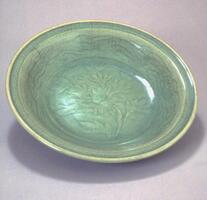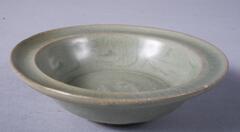Cabinet P: Shelf 1
Celadon Wares in Asia
Although Celadon is the term for a translucent crackle glaze applied to porcelain and stoneware, it has come to mean wares that are specifically greenish blue or gray in color, particularly those from China and Korea. The trademark greenish hues of celadon wares were achieved through the use of clays and glazes that contained small amounts of iron, which turns green in a reduction firing atmosphere. (When there is insufficient oxygen in the air in a kiln, oxygen molecules are pulled from the ceramics themselves; it is this change in chemical composition that changes the color of the ware.) The thickness of the glaze and type of clay determine the color after firing, and getting the “right” effect is extremely difficult. The thin watery glaze runs off high points in the design and pools in impressions, creating dazzling gradations in color, especially in incised and molded designs.
Jade was prized in East Asia, and the ability to imitate its color in porcelain was highly valued. In the Goryeo Period (918-1392) in Korea, a celadon ewer or teacup was more precious than gold or silver. The high estimation of celadon was not limited to Korea, but extended to discerning connoisseurs at the court of the Northern Song dynasty (960–1127) in China. Celadon was quite popular in Japan as well, where it was both imported and manufactured in a native version. Celadon is considered by many to have reached its height during the Goryeo period, and these wares continue to be prized by collectors today.
Created For
K-12 EducatorK-12 Student
Museum Visitor
UMMA Docent
UMMA Staff
University Faculty
University Student
Rate this Resource
AVG: 0 | Ratings: 0
& Author Notes
Creative Commons by-nc-saLast Updated
June 8, 2020 12:55 p.m.Report
Reporting Policy
![<p>The long neck, curvilinear body, and ared mouth of this vessel create a typical Goryeo celadon bottle. A band of lotus petals inlaid with black and white slips is wrapped around the lower part of the neck, below which is a yeoui-head band inlaid with white slip. Three places around the belly of the bottle are decorated with lotus sprays inlaid with black and white slips. The glaze on the lower part of the body has been oxidized, where it is also extensively cracked. The foot is low, with a wide rim, and has sand spur marks.<br />
[Korean Collection, University of Michigan Museum of Art (2014) p.143]</p>
<p>The long neck, curvilinear body, and ared mouth of this vessel create a typical Goryeo celadon bottle. A band of lotus petals inlaid with black and white slips is wrapped around the lower part of the neck, below which is a yeoui-head band inlaid with white slip. Three places around the belly of the bottle are decorated with lotus sprays inlaid with black and white slips. The glaze on the lower part of the body has been oxidized, where it is also extensively cracked. The foot is low, with a wide rim, and has sand spur marks.<br />
[Korean Collection, University of Michigan Museum of Art (2014) p.143]</p>](/media/W1siZiIsIjIwMjIvMDkvMjQvMXFmdnRueTRuNl9kZWZhdWx0LmpwZyJdLFsicCIsInRodW1iIiwiMjQweDIwMCJdXQ?sha=0ca4162fd5e5e61f)
![<p>A circle is incised on the wide inner base of this bowl; the base is decorated with a chrysanthemum floret and is surrounded by lotus scrolls on the wall. There is a crack on the inner base which formed during firing, but the overall state of sintering is fine. There are six refractory spur marks on the foot. Part of the mouth had been broken off and restored.<br />
[<em>Korean Collection, University of Michigan Museum of Art </em>(2014) p.95]</p>
The celadon bowl is close in shape to a perfect hemisphere, and its rim is turned very slightly outward. There is a peony design on the wall and bottom. The color is olive grey. It has a small concave foot. <p>A circle is incised on the wide inner base of this bowl; the base is decorated with a chrysanthemum floret and is surrounded by lotus scrolls on the wall. There is a crack on the inner base which formed during firing, but the overall state of sintering is fine. There are six refractory spur marks on the foot. Part of the mouth had been broken off and restored.<br />
[<em>Korean Collection, University of Michigan Museum of Art </em>(2014) p.95]</p>
The celadon bowl is close in shape to a perfect hemisphere, and its rim is turned very slightly outward. There is a peony design on the wall and bottom. The color is olive grey. It has a small concave foot.](/media/W1siZiIsIjIwMjIvMDkvMjQvNXl3NXZucWgyZl9kZWZhdWx0LmpwZyJdLFsicCIsInRodW1iIiwiMjQweDIwMCJdXQ?sha=252796f0a02b862c)


![<p>This bowl features splendid designs inlaid with black and white slip on its inner and outer surfaces. The inner wall is decorated with black-and- white inlaid design of three cranes surrounded by clouds which is inlaid with white slip. A row of yeoui-head designs borders the inner bottom. The outer surface also features chrysanthemum designs inside double concentric circles, all inlaid with white slip. Fine sand was stuck to the shallow foot. Glaze has been peeled off in some parts of the mouth, but the bowl is generally in complete form.<br />
[<em>Korean Collection, University of Michigan Museum of Art</em> (2014) p.108]</p>
<p>This bowl features splendid designs inlaid with black and white slip on its inner and outer surfaces. The inner wall is decorated with black-and- white inlaid design of three cranes surrounded by clouds which is inlaid with white slip. A row of yeoui-head designs borders the inner bottom. The outer surface also features chrysanthemum designs inside double concentric circles, all inlaid with white slip. Fine sand was stuck to the shallow foot. Glaze has been peeled off in some parts of the mouth, but the bowl is generally in complete form.<br />
[<em>Korean Collection, University of Michigan Museum of Art</em> (2014) p.108]</p>](/media/W1siZiIsIjIwMjIvMDkvMjQvNjViOHhwdzlvcl9kZWZhdWx0LmpwZyJdLFsicCIsInRodW1iIiwiMjQweDIwMCJdXQ?sha=51e90aadb9d5edf2)
![The vase has a slightly outward-turned rim and a short neck. The elegantly-shaped bottle flares out to a broad shoulder, then tapers gradually to a slim waist before flaring out once more at the base. The shoulder, mid-belly and base of the vase are decorated with black and white clay-inlaid cloud, crane and butterfly motifs.
<p>The body of this vase is inlaid with clouds with black slip and butterflies inlaid with black and white slips, while the lower body is decorated with incised fret-patterned band. The mouth has been completely destroyed and repaired once, but has now fallen into decay. The glaze at the foot is opaque and cracked because of the low ring temperature and it has many pinholes on one side. Glaze was wiped away from the base, and there remain refractory spur marks.<br />
[<em>Korean Collection, University of Michigan Museum of Art</em> (2014) p.137]</p>
The vase has a slightly outward-turned rim and a short neck. The elegantly-shaped bottle flares out to a broad shoulder, then tapers gradually to a slim waist before flaring out once more at the base. The shoulder, mid-belly and base of the vase are decorated with black and white clay-inlaid cloud, crane and butterfly motifs.
<p>The body of this vase is inlaid with clouds with black slip and butterflies inlaid with black and white slips, while the lower body is decorated with incised fret-patterned band. The mouth has been completely destroyed and repaired once, but has now fallen into decay. The glaze at the foot is opaque and cracked because of the low ring temperature and it has many pinholes on one side. Glaze was wiped away from the base, and there remain refractory spur marks.<br />
[<em>Korean Collection, University of Michigan Museum of Art</em> (2014) p.137]</p>](/media/W1siZiIsIjIwMjIvMDUvMjUvZWRiaGFnd2pvX2RlZmF1bHQuanBnIl0sWyJwIiwidGh1bWIiLCIyNDB4MjAwIl1d?sha=311f4bfb4608e381)
![<p>The beginning of the 14th century saw a change in inlaid patterns from using both black and white clay to only using white clay, as demonstrated by this bowl. Concentric white circles extend around the upper and lower parts of the inner and outer surfaces, while the inner wall features a chrysanthemum design in three places. Sand is stuck to the foot and the outer base. The bowl is tinged with vivid yellow. Parts of the rim are slightly damaged, but the glaze is finely fused.<br />
[<em>Korean Collection, University of Michigan Museum of Art </em>(2014) p.107]</p>
<p>The beginning of the 14th century saw a change in inlaid patterns from using both black and white clay to only using white clay, as demonstrated by this bowl. Concentric white circles extend around the upper and lower parts of the inner and outer surfaces, while the inner wall features a chrysanthemum design in three places. Sand is stuck to the foot and the outer base. The bowl is tinged with vivid yellow. Parts of the rim are slightly damaged, but the glaze is finely fused.<br />
[<em>Korean Collection, University of Michigan Museum of Art </em>(2014) p.107]</p>](/media/W1siZiIsIjIwMjIvMDkvMjQvMjN4bWZrM29rYl9kZWZhdWx0LmpwZyJdLFsicCIsInRodW1iIiwiMjQweDIwMCJdXQ?sha=00c2f5b728ac5938)

